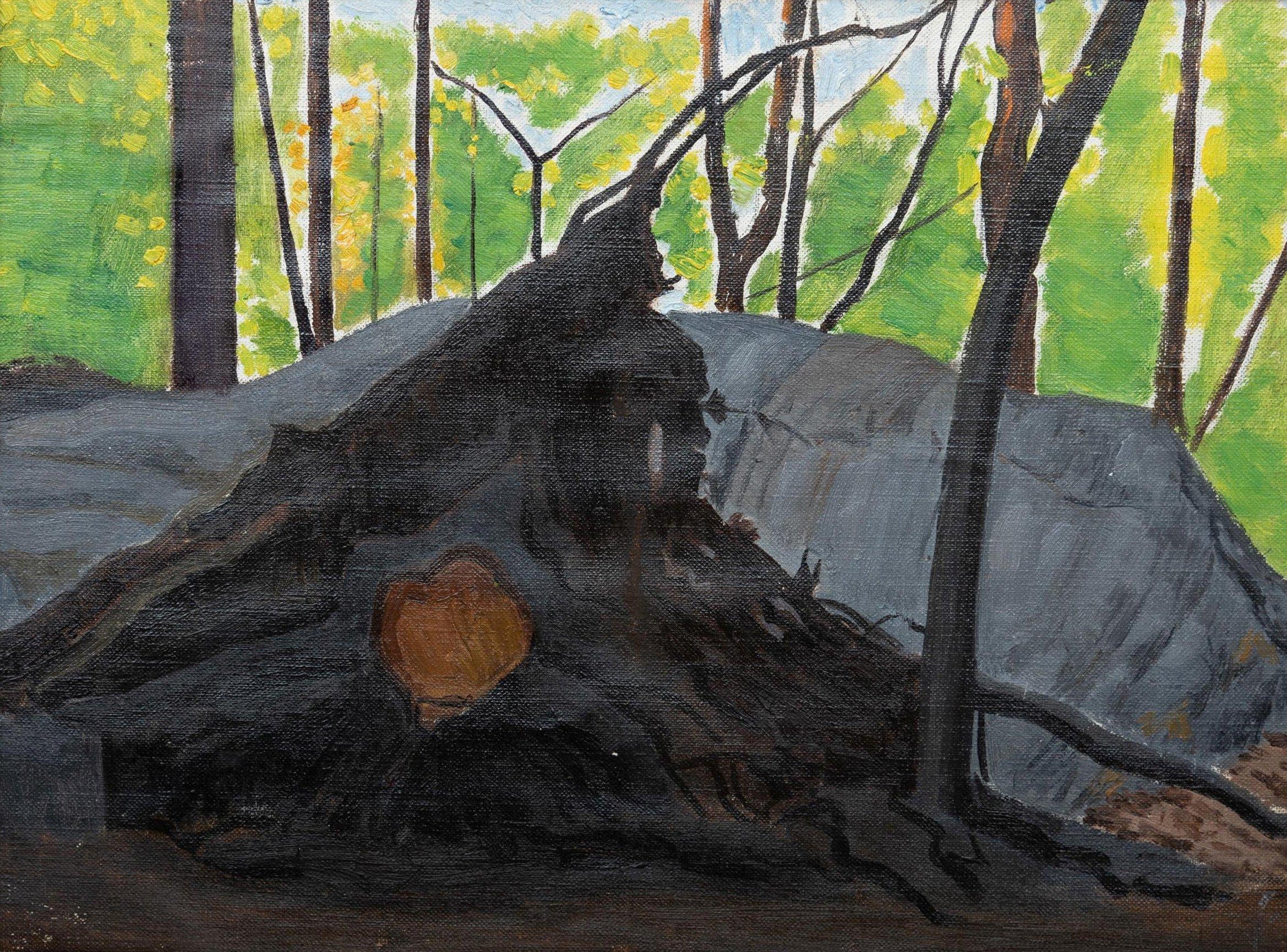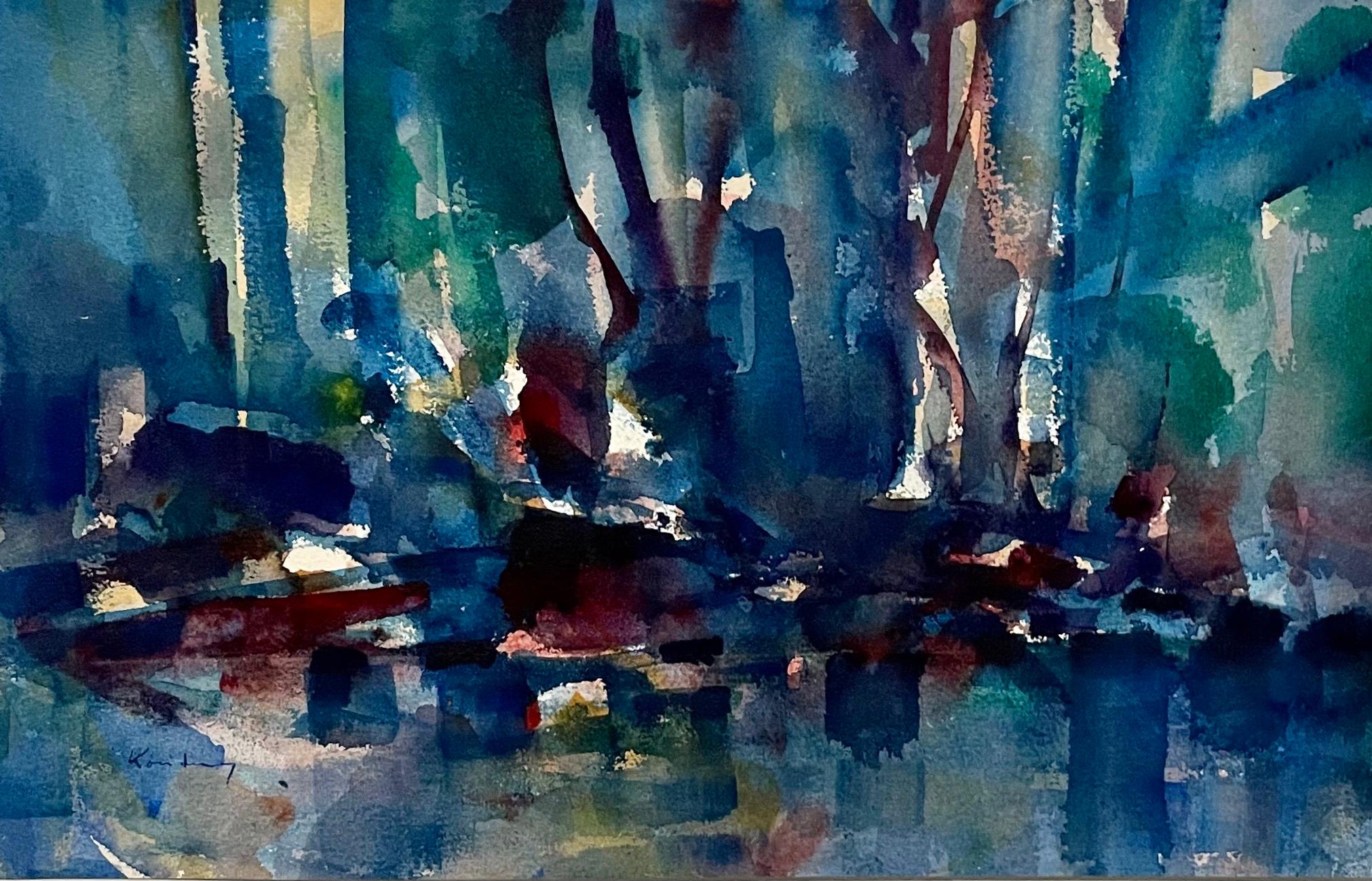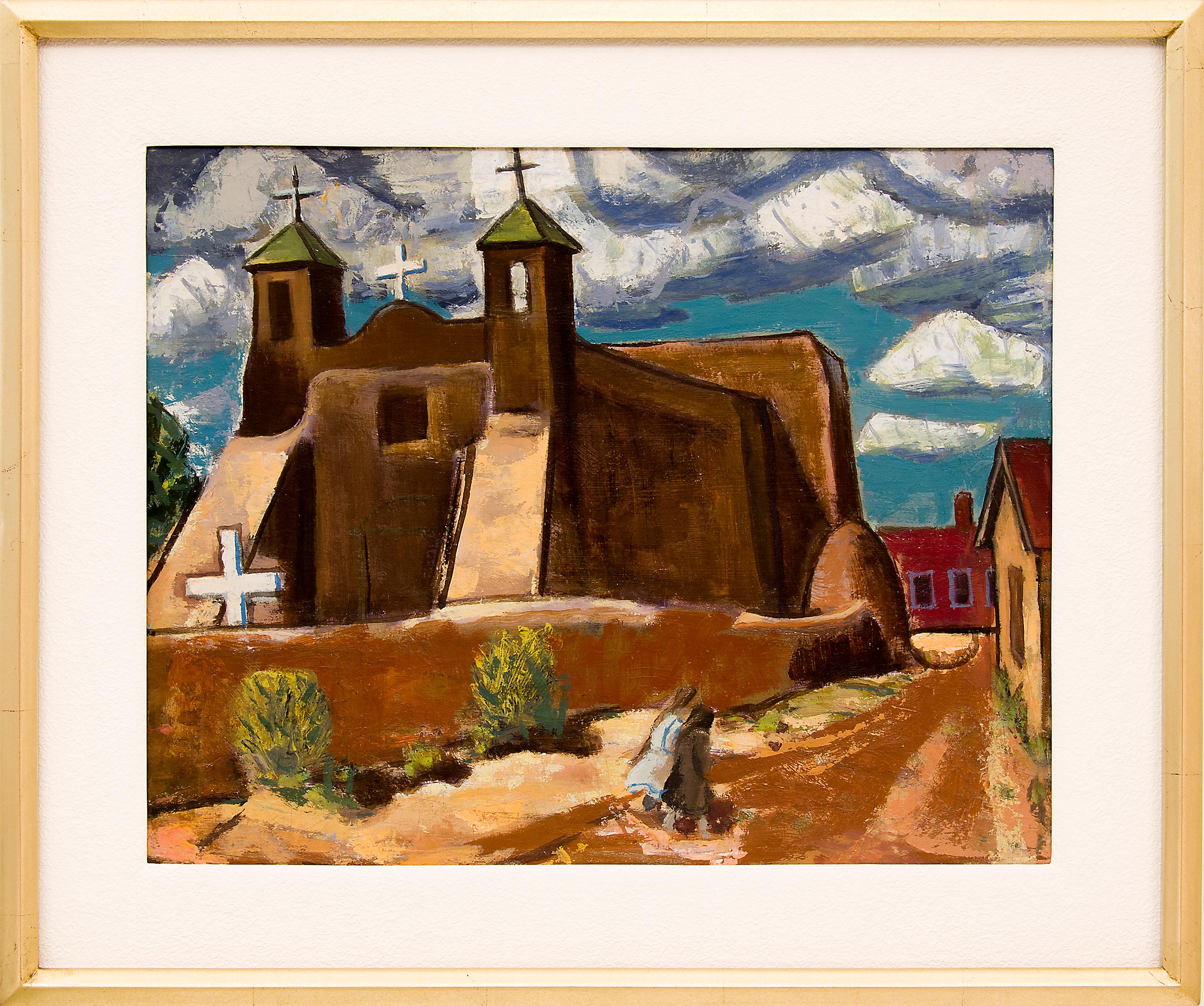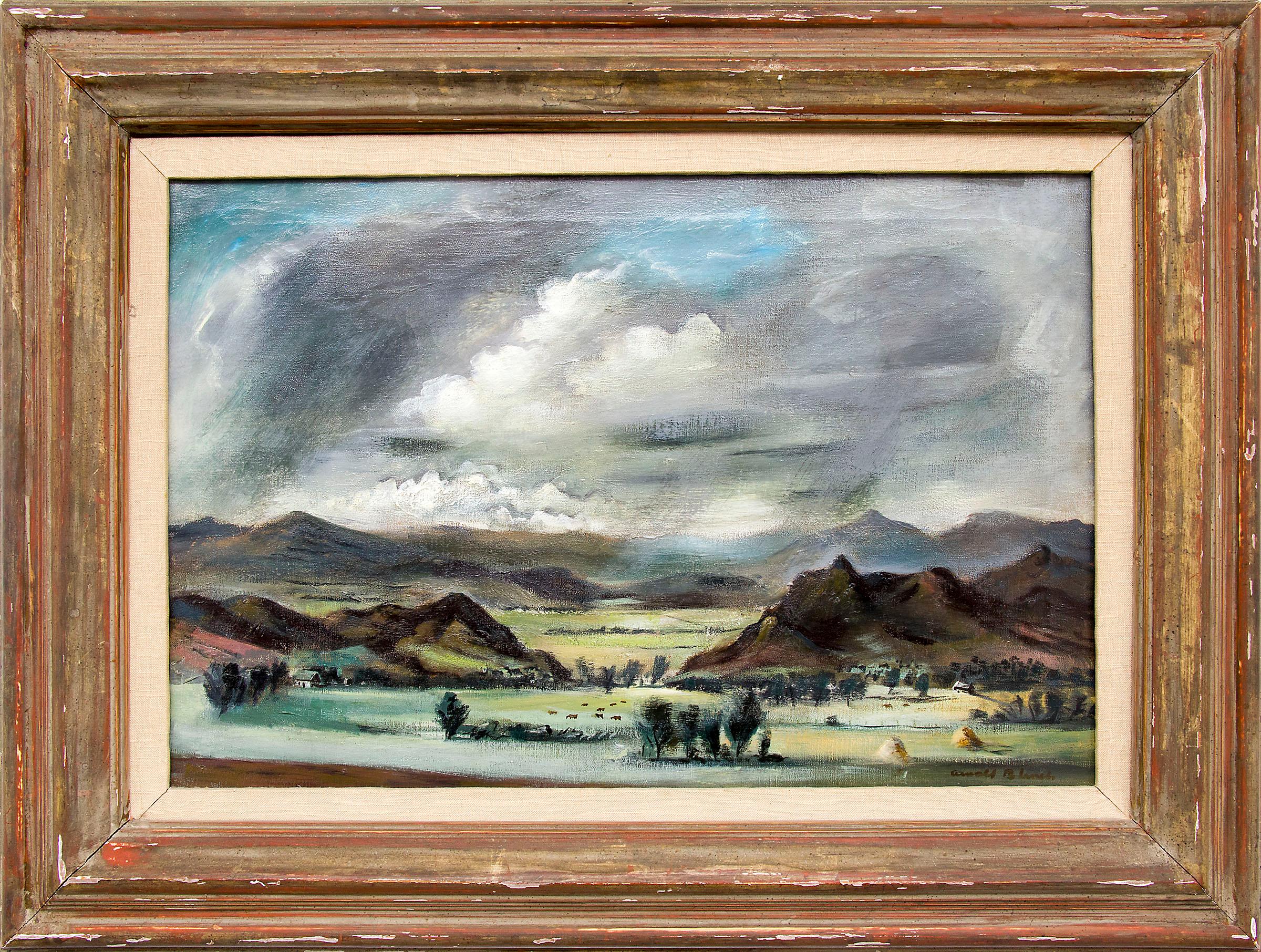Items Similar to “Abstract Sailboats”
Want more images or videos?
Request additional images or videos from the seller
1 of 12
William Katz“Abstract Sailboats”Circa 1955
Circa 1955
About the Item
Fabulous original mid century modern oil on canvas painting by the well known New York artist, William Katz. The painting is done in a colorful abstraction of sailboats and is signed by the artist lower left. The artist has mixed sand into the oil paint to give the painting a highly textured look. Condition is excellent. Circa 1955. The frame is original with a studded gold edge detailing and with natural wood sides. Frame is in fine original condition. Overall framed measurements are 17 by 29.25 inches. Provenance: A Saint Petersburg, Florida collector.
William P. Katz (1926-2003) American
William Katz was born in New York, studied at The Art Students League and with Sebastiano Mineo of New York City. For five years he worked and lived in the home that was once occupied by the great American sculptor Gutson Borglum. His works are in many private collections in the United States, Norway, England, Canada and Greece.
Best known for sculptures, he also created paintings and designed textiles and jewelry. Alexander Kirkland called him an abstract "figurist-fantasist."
He has had one-man exhibits at many galleries including: 1964, Miami Museum of Modern Art, Miami, FL; 1965, Fordham University, NYC; 1969 Hiram Halle Library, Pound Ridge, NY
- Creator:William Katz (1926 - 2003, American)
- Creation Year:Circa 1955
- Dimensions:Height: 16 in (40.64 cm)Width: 28 in (71.12 cm)Depth: 2 in (5.08 cm)
- Medium:
- Movement & Style:
- Period:
- Condition:
- Gallery Location:Southampton, NY
- Reference Number:1stDibs: LU14113980052
About the Seller
5.0
Platinum Seller
These expertly vetted sellers are 1stDibs' most experienced sellers and are rated highest by our customers.
Established in 1977
1stDibs seller since 2013
476 sales on 1stDibs
Typical response time: <1 hour
- ShippingRetrieving quote...Ships From: Sarasota, FL
- Return PolicyA return for this item may be initiated within 7 days of delivery.
More From This SellerView All
- "Twin Cities"By Nahum TschacbasovLocated in Southampton, NYThis rare and wonderful oil on canvas landscape by Nahum Tschacbasov was done circa 1947. A slightly smaller version of this painting by Tschacbasov called "Night and Day" is illust...Category
1940s American Modern Landscape Paintings
MaterialsCanvas, Oil
- "Garden Splendor"By Nicolai CikovskyLocated in Southampton, NYOil on canvas painting by the Russian/American artist, Nicolai Cikovsky. Signed lower left. In good unrestored condition. Housed in custom made wood and lemon gold gilt frame. Overal...Category
1940s American Modern Landscape Paintings
MaterialsCanvas, Oil
- “Bouquet by the Sea”By Nicolai CikovskyLocated in Southampton, NYOil on artist board original painting by the well known American artist, Nicolai Cikovsky. Thick vibrant colors with a vase of flowers, a banjo and a notebook with photographs with a rough sea as the background. Circa 1940. Condition is very good. Overall framed in a circa 1960 frame, 23 by 27.25 inches. Landscape and figure painter Nicolai S. Cikovsky, 1894-1984, was born in Russia, where he studied at the Vilna Art School, 1910-1914; the Penza Royal Art School, 1914-1918; and Moscow High Tech Art...Category
1940s American Modern Landscape Paintings
MaterialsCanvas, Oil
- "Le Cheval Blanc"By Nahum TschacbasovLocated in Southampton, NYOil on masonite painting by the Russian/American artist Nahum Tschacbasov. Signed middle right and dated 1955. It depicts a white stallion riding on a wooden raft in rough seas with...Category
1950s American Modern Landscape Paintings
MaterialsOil, Masonite
- “Oil Tankers”By Whitney Myron HubbardLocated in Southampton, NYOil on cardstock painting of oil tankers docked in port along with people dockside on a bright clear day by the Long Island American artist, Whitney Myron H...Category
1940s American Modern Landscape Paintings
MaterialsCardboard, Oil
- "Fireglow Sunset"By Nahum TschacbasovLocated in Southampton, NYOil on artist board mounted on wood panel. Tschacbasov sunset sets the trees ablaze in this beautiful painting done in the late 1950's while two small figures in the lower right side...Category
1950s American Modern Landscape Paintings
MaterialsOil
You May Also Like
- "Tree, Trunk, and Roots, New York" Joseph Stella, American ModernismBy Joseph StellaLocated in New York, NYJoseph Stella (1877 - 1946) Tree, Trunk, and Roots, Bronx, New York, circa 1924 Oil on canvas 12 x 16 inches inscribed in another hand Joseph Stella/Estate and bears Joseph Stella Estate stamp (on the reverse) Provenance: The Estate of the Artist Rabin & Kreuger, New Jersey Parke Bernet Galleries, New York, March 14, 1968, Lot 147 ACA Galleries, New York Thence by descent Stella was born June 13, 1877 at Muro Lucano, Italy, a mountain village not far from Naples. He became painter laureate of Muro Lucano when he was in his teens with a representation of the local saint in the village church. Stella immigrated to America in 1896 and studied medicine and pharmacology, but upon the advice of artist friend Carlo de Fornaro, who recognized his undeveloped talent, he enrolled at the Art Students League in 1897. Stella objected to the rule forbidding the painting of flowers, an indication of his lifelong devotion to flower painting. He also studied under William Merritt Chase in the New York School of Art and at Shinnecock Hills, Long Island in 1901-1902, displaying the bravura brushwork and dark Impressionist influence of Chase. Stella liked to paint the raw street life of immigrant society, rendering this element more emotionally than the city realists, the Aschcan School headed by Robert Henri. Stella went through a progression of styles--from realism to abstraction--mixing media and painting simultaneously in different manners, reviving styles and subjects years later. The "Survey" sent Stella to illustrate the mining disaster of 1907 in Monongah, West Virginia, and in 1908 commissioned him to execute drawings of the Pittsburgh industrial scene. Steel and electricity became a major experience in shaping his responses to the modern world, and Stella succeeded in portraying the pathos of the steelworkers and the Pittsburgh landscape. Stella went abroad in 1909 at the age of thirty-two, lonely for his native land. He returned to Italy, traveling to Venice, Florence and Rome. He took up the glazing technique of the old Venetian masters to get warmth, transparency, and depth of color. One of Stella's paintings was shown in the International Exhibition in Rome in 1910 and was acquired by the city of Rome. The influence of the French Modernists awakened his dormant individuality. His friendship with Antonio Mancini, a Futurist, also played a role in his new style. At the urging of Walter Pach...Category
1920s American Modern Landscape Paintings
MaterialsCanvas, Oil
- Modernist Abstract Expressionist Watercolor Painting Bauhaus Weimar Pawel KontnyBy Pawel KontnyLocated in Surfside, FLAbstract watercolor composition bearing the influence of the earlier color-block compositions of Paul Klee. Pawel August Kontny, (Polish-German-American artist) He was born in Laurahuette, Poland, in 1923, the son of a wealthy pastry shop owner. In 1939 he began studying architecture in Breslau where he was introduced to the European masters and to the work of some of the German Expressionists, soon afterward banned as "degenerate artists" and removed from museums throughout Germany by the Nazi regime. His studies were interrupted by World War II. Drafted into the German army, traveling in many countries as a soldier, he sketched various landscapes but in 1945, he was captured and held as a prisoner of war in Italy. After the war, he studied at the Union of Nuremberg Architects to help design buildings to replace ones destroyed in the war. He recorded his impressions of the local population and the landscapes through his watercolors and drawings. Pawel Kontny thereafter moved to Nuremberg, Germany, becoming a member of the Union of Nuremberg Architects and helping to rebuild the city's historic center. He soon decided to concentrate on his professional art career. He married Irmgard Laurer, a dancer with the Nuremberg Opera. Pavel Kontny 's career as an artist was launched with his participation in an all German exhibition, held at the Dusseldorf Museum in 1952. He held one-man shows in Germany, Switzerland and the United States. During his trip to the United States in 1960, Kontny became instantly enamored with Colorado, and decided to relocate to Cherry Hills with his wife and two children. He quickly established himself in the local art community, being affiliated for a time with Denver Art Galleries and Saks Galleries. His subject matter became the Southwest. During this time he received the Prestigious Gold Medal of the Art Academy of Rome. His extensive travel provided material for the paintings he did using his hallmark marble dust technique. he also worked equally in pastel, watercolor, charcoal and pencil-and-ink. in a style which merged abstraction and realist styles, influenced by Abstract Expressionist painting and South Western American landscapes. In the early 1960s he was one of only a few European-born professional artists in the state, a select group that included Herbert Bayer (1900-1985), a member of the prewar Bauhaus in Weimar and Dessau, Germany, and Roland Detre (1903-2001), a Hungarian modernist painter. As a Denver, Colorado resident, Pavel Kontny exhibited at galleries and museums throughout the United States, Germany and Japan. There, he was inspired by frequent trips to Native American pueblos in the Southwest, as well as by the study of the Plains Indians of Montana and Wyoming. Over the years Kontny had a number of students and generously helped young artist by hosting exhibitions at his Cherry Hills home. For many years he generously donated his paintings to support charitable causes in Denver. Influences during his European years included German pastelist C.O. Muller, German Informel painter Karl Dahmen and Swiss artist, Hans Erni. In the early 1950s his painting style showed the influence of the Die Brücke (The Bridge), a group of German expressionist artists formed in Dresden in 1905 who had a major impact on the evolution of modern art in the twentieth century in Germany. By the middle of the decade his style incorporated more referential abstraction and total abstraction, resulting in part from his study of Hans Hartung, a German artist based in Paris who exhibited his gestural abstract work in Germany. The American moon landing in 1969 inspired Paul Kontny...Category
20th Century American Modern Landscape Paintings
MaterialsCanvas, Oil
- Adobe Church, New Mexico, 1940s Modernist Southwestern Landscape Oil PaintingBy Paul Kauvar SmithLocated in Denver, COVintage 1930s - 1940s oil painting of an adobe church in New Mexico with a brilliant blue sky and clouds (likely Rancho de Taos), circa 1940. Painted by Denver modernist, Paul K...Category
1940s American Modern Landscape Paintings
MaterialsCanvas, Oil
- Colorado Mountain Summer Landscape, 1930s Framed Modernist Oil PaintingBy Arnold BlanchLocated in Denver, COVintage Modernist WPA era painting by Arnold Blanch (1896-1968) of a Colorado Landscape, likely near Colorado Springs, Colorado, with green fields, red rocks and mountains in the background under a moody sky. Dominant colors include, green, yellow, red/brown, gray, white and blue. Painting is clean and in good vintage condition - please contact us for a detailed condition report. About the Artist: Arnold Blanch was an illustrator, printmaker, teacher and painter. He was primarily known for his landscape, genre, figurative, realist, and surrealist paintings. Born in Manterville, Minnesota, he was encouraged to study art by his mother, an amateur artist. He began studying at the Minneapolis Art Institute in 1914. In 1916, he received a scholarship to study in New York at the Art Students League. In New York, he studied under Robert Henri, Francis Luis Mora, Boardman Robinson, John Sloan, and Kenneth Hayes Miller. In 1919, Blanch arrived in Woodstock, New York to study at the Art Students League summer school. He married his fellow student Lucile Lundquist, and they settled in Woodstock in 1922 after traveling to France for a year. Blanch remained in Woodstock for more than forty years, until his death. He was an important figure in the Woodstock Artists Association, as he devoted much of his time to maintaining financial and moral support for the Association. Throughout his life, Blanch had more than sixty solo and group exhibits. He was awarded the Guggenheim Foundation Fellowship in 1940. In 1962, he had a retrospective at the Krasner Gallery in New York. Blanch's artistic style changed frequently throughout his career. After the 1930's, Blanch's palette became lighter and his subjects became less serious. In the 1930s, after he and his first wife separated, Blanch became romantically involved with artist Doris Lee, and both were influenced by each other's artistic styles for the next thirty years. Blanch was also influenced by the Abstract Expressionists; however, he primarily remained a figurative painter. His last artistic style consisted of shallow pictoral space and tightly arranged structures. ©David Cook Galleries...Category
1930s American Modern Landscape Paintings
MaterialsCanvas, Oil
- Modernist Landscape with a Hop Scotch BoardBy Karl FortressLocated in Buffalo, NYA modernist oil painting by New York modernist Karl Fortress (1907-1993). The painting has provenance from the Cornell Art Museum. In excellent original condition. Signed lower le...Category
1930s American Modern Landscape Paintings
MaterialsOil, Canvas
- Ventian CourtyardBy Enid SmileyLocated in Buffalo, NYAn original oil on canvas by listed New York female artist Enid Smiley.Category
1950s American Modern Landscape Paintings
MaterialsOil, Canvas
Recently Viewed
View AllMore Ways To Browse
Sailboat Framed
Katz Artist
Landscapes With Sailboat
Sailboat Vintage
Vintage Sailboat
Sailboat Oil
Katz Vintage
Sailboat Oil Paintings
Florida Landscape Paintings Modern
Oil Paintings Of Sailboats
Sailboat Oil Canvas
Sailboat Oil Canvas Paintings
Florida Original Landscape Paintings
Sailboat Oil On Canvas
Vintage Sailboat Painting
Gold Sailboat
Abstract Sailboat
Sailboat Mid Century




